13.74: Skeletal Muscles
- Page ID
- 13271
\( \newcommand{\vecs}[1]{\overset { \scriptstyle \rightharpoonup} {\mathbf{#1}} } \)
\( \newcommand{\vecd}[1]{\overset{-\!-\!\rightharpoonup}{\vphantom{a}\smash {#1}}} \)
\( \newcommand{\dsum}{\displaystyle\sum\limits} \)
\( \newcommand{\dint}{\displaystyle\int\limits} \)
\( \newcommand{\dlim}{\displaystyle\lim\limits} \)
\( \newcommand{\id}{\mathrm{id}}\) \( \newcommand{\Span}{\mathrm{span}}\)
( \newcommand{\kernel}{\mathrm{null}\,}\) \( \newcommand{\range}{\mathrm{range}\,}\)
\( \newcommand{\RealPart}{\mathrm{Re}}\) \( \newcommand{\ImaginaryPart}{\mathrm{Im}}\)
\( \newcommand{\Argument}{\mathrm{Arg}}\) \( \newcommand{\norm}[1]{\| #1 \|}\)
\( \newcommand{\inner}[2]{\langle #1, #2 \rangle}\)
\( \newcommand{\Span}{\mathrm{span}}\)
\( \newcommand{\id}{\mathrm{id}}\)
\( \newcommand{\Span}{\mathrm{span}}\)
\( \newcommand{\kernel}{\mathrm{null}\,}\)
\( \newcommand{\range}{\mathrm{range}\,}\)
\( \newcommand{\RealPart}{\mathrm{Re}}\)
\( \newcommand{\ImaginaryPart}{\mathrm{Im}}\)
\( \newcommand{\Argument}{\mathrm{Arg}}\)
\( \newcommand{\norm}[1]{\| #1 \|}\)
\( \newcommand{\inner}[2]{\langle #1, #2 \rangle}\)
\( \newcommand{\Span}{\mathrm{span}}\) \( \newcommand{\AA}{\unicode[.8,0]{x212B}}\)
\( \newcommand{\vectorA}[1]{\vec{#1}} % arrow\)
\( \newcommand{\vectorAt}[1]{\vec{\text{#1}}} % arrow\)
\( \newcommand{\vectorB}[1]{\overset { \scriptstyle \rightharpoonup} {\mathbf{#1}} } \)
\( \newcommand{\vectorC}[1]{\textbf{#1}} \)
\( \newcommand{\vectorD}[1]{\overrightarrow{#1}} \)
\( \newcommand{\vectorDt}[1]{\overrightarrow{\text{#1}}} \)
\( \newcommand{\vectE}[1]{\overset{-\!-\!\rightharpoonup}{\vphantom{a}\smash{\mathbf {#1}}}} \)
\( \newcommand{\vecs}[1]{\overset { \scriptstyle \rightharpoonup} {\mathbf{#1}} } \)
\( \newcommand{\vecd}[1]{\overset{-\!-\!\rightharpoonup}{\vphantom{a}\smash {#1}}} \)
\(\newcommand{\avec}{\mathbf a}\) \(\newcommand{\bvec}{\mathbf b}\) \(\newcommand{\cvec}{\mathbf c}\) \(\newcommand{\dvec}{\mathbf d}\) \(\newcommand{\dtil}{\widetilde{\mathbf d}}\) \(\newcommand{\evec}{\mathbf e}\) \(\newcommand{\fvec}{\mathbf f}\) \(\newcommand{\nvec}{\mathbf n}\) \(\newcommand{\pvec}{\mathbf p}\) \(\newcommand{\qvec}{\mathbf q}\) \(\newcommand{\svec}{\mathbf s}\) \(\newcommand{\tvec}{\mathbf t}\) \(\newcommand{\uvec}{\mathbf u}\) \(\newcommand{\vvec}{\mathbf v}\) \(\newcommand{\wvec}{\mathbf w}\) \(\newcommand{\xvec}{\mathbf x}\) \(\newcommand{\yvec}{\mathbf y}\) \(\newcommand{\zvec}{\mathbf z}\) \(\newcommand{\rvec}{\mathbf r}\) \(\newcommand{\mvec}{\mathbf m}\) \(\newcommand{\zerovec}{\mathbf 0}\) \(\newcommand{\onevec}{\mathbf 1}\) \(\newcommand{\real}{\mathbb R}\) \(\newcommand{\twovec}[2]{\left[\begin{array}{r}#1 \\ #2 \end{array}\right]}\) \(\newcommand{\ctwovec}[2]{\left[\begin{array}{c}#1 \\ #2 \end{array}\right]}\) \(\newcommand{\threevec}[3]{\left[\begin{array}{r}#1 \\ #2 \\ #3 \end{array}\right]}\) \(\newcommand{\cthreevec}[3]{\left[\begin{array}{c}#1 \\ #2 \\ #3 \end{array}\right]}\) \(\newcommand{\fourvec}[4]{\left[\begin{array}{r}#1 \\ #2 \\ #3 \\ #4 \end{array}\right]}\) \(\newcommand{\cfourvec}[4]{\left[\begin{array}{c}#1 \\ #2 \\ #3 \\ #4 \end{array}\right]}\) \(\newcommand{\fivevec}[5]{\left[\begin{array}{r}#1 \\ #2 \\ #3 \\ #4 \\ #5 \\ \end{array}\right]}\) \(\newcommand{\cfivevec}[5]{\left[\begin{array}{c}#1 \\ #2 \\ #3 \\ #4 \\ #5 \\ \end{array}\right]}\) \(\newcommand{\mattwo}[4]{\left[\begin{array}{rr}#1 \amp #2 \\ #3 \amp #4 \\ \end{array}\right]}\) \(\newcommand{\laspan}[1]{\text{Span}\{#1\}}\) \(\newcommand{\bcal}{\cal B}\) \(\newcommand{\ccal}{\cal C}\) \(\newcommand{\scal}{\cal S}\) \(\newcommand{\wcal}{\cal W}\) \(\newcommand{\ecal}{\cal E}\) \(\newcommand{\coords}[2]{\left\{#1\right\}_{#2}}\) \(\newcommand{\gray}[1]{\color{gray}{#1}}\) \(\newcommand{\lgray}[1]{\color{lightgray}{#1}}\) \(\newcommand{\rank}{\operatorname{rank}}\) \(\newcommand{\row}{\text{Row}}\) \(\newcommand{\col}{\text{Col}}\) \(\renewcommand{\row}{\text{Row}}\) \(\newcommand{\nul}{\text{Nul}}\) \(\newcommand{\var}{\text{Var}}\) \(\newcommand{\corr}{\text{corr}}\) \(\newcommand{\len}[1]{\left|#1\right|}\) \(\newcommand{\bbar}{\overline{\bvec}}\) \(\newcommand{\bhat}{\widehat{\bvec}}\) \(\newcommand{\bperp}{\bvec^\perp}\) \(\newcommand{\xhat}{\widehat{\xvec}}\) \(\newcommand{\vhat}{\widehat{\vvec}}\) \(\newcommand{\uhat}{\widehat{\uvec}}\) \(\newcommand{\what}{\widehat{\wvec}}\) \(\newcommand{\Sighat}{\widehat{\Sigma}}\) \(\newcommand{\lt}{<}\) \(\newcommand{\gt}{>}\) \(\newcommand{\amp}{&}\) \(\definecolor{fillinmathshade}{gray}{0.9}\)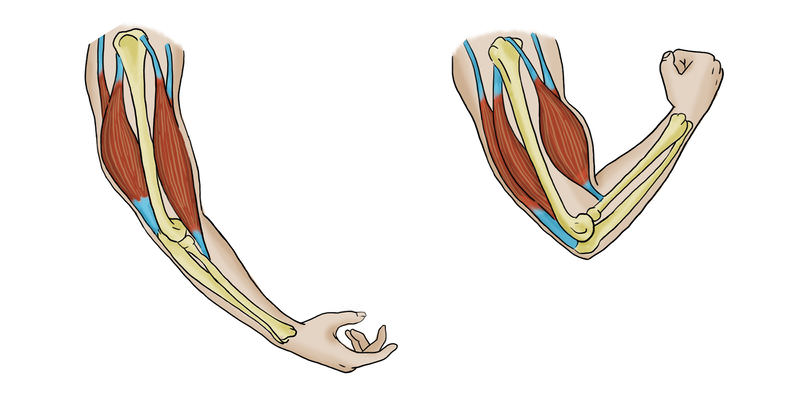
How do your bones move?
By the contraction and extension of your skeletal muscles. Notice how the muscles are attached to the bones. The muscles pull on the bones, causing movement.
Skeletal Muscles
There are well over 600 skeletal muscles in the human body, some of which are identified in Figure below. Skeletal muscles vary considerably in size, from tiny muscles inside the middle ear to very large muscles in the upper leg.
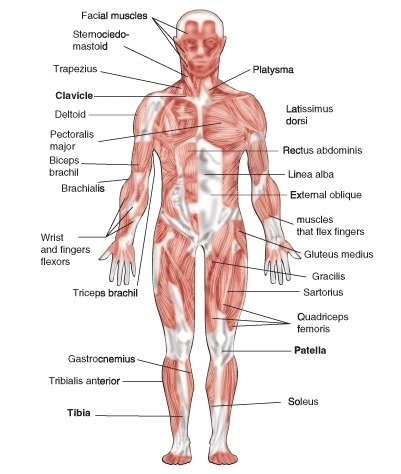 Skeletal Muscles. Skeletal muscles enable the body to move.
Skeletal Muscles. Skeletal muscles enable the body to move.Structure of Skeletal Muscles
Each skeletal muscle consists of hundreds or even thousands of skeletal muscle fibers. The fibers are bundled together and wrapped in connective tissue, as shown Figure below. The connective tissue supports and protects the delicate muscle cells and allows them to withstand the forces of contraction. It also provides pathways for nerves and blood vessels to reach the muscles. Skeletal muscles work hard to move body parts. They need a rich blood supply to provide them with nutrients and oxygen and to carry away their wastes.
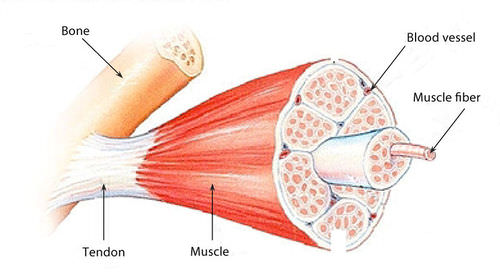 Skeletal Muscle Structure. A skeletal muscle contains bundles of muscle fibers inside a “coat” of connective tissue.
Skeletal Muscle Structure. A skeletal muscle contains bundles of muscle fibers inside a “coat” of connective tissue.Skeletal Muscles and Bones
Skeletal muscles are attached to the skeleton by tough connective tissues called tendons (see Figure above). Many skeletal muscles are attached to the ends of bones that meet at a joint. The muscles span the joint and connect the bones. When the muscles contract, they pull on the bones, causing them to move.
Muscles can only contract. They cannot actively extend, or lengthen. Therefore, to move bones in opposite directions, pairs of muscles must work in opposition. For example, the biceps and triceps muscles of the upper arm work in opposition to bend and extend the arm at the elbow (see Figure below). What other body movements do you think require opposing muscle pairs?
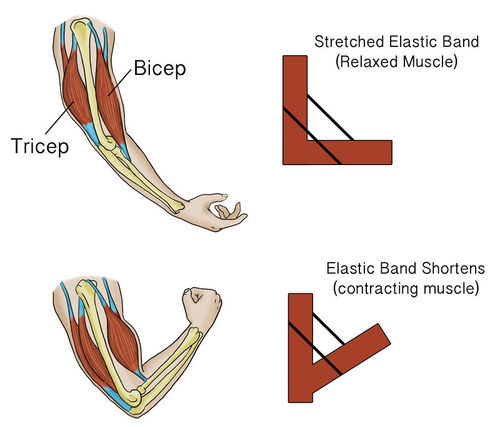 Triceps and biceps muscles in the upper arm are opposing muscles.
Triceps and biceps muscles in the upper arm are opposing muscles.Use It or Lose It
In exercises such as weight lifting, skeletal muscle contracts against a resisting force (see Figure below). Using skeletal muscle in this way increases its size and strength. In exercises such as running, the cardiac muscle contracts faster and the heart pumps more blood. Using cardiac muscle in this way increases its strength and efficiency. Continued exercise is necessary to maintain bigger, stronger muscles. If you don’t use a muscle, it will get smaller and weaker—so use it or lose it.
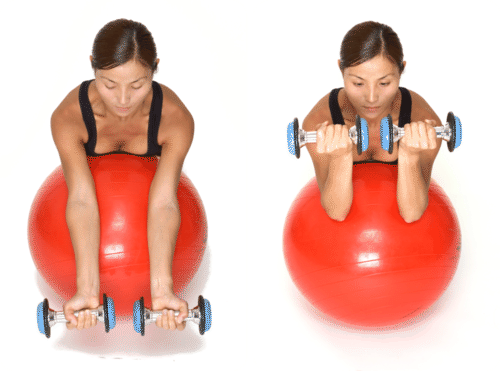 This exercise pits human muscles against a force. What force is it?
This exercise pits human muscles against a force. What force is it?Summary
- Skeletal muscles are attached to the skeleton and cause bones to move when they contract.
Review
- What is a muscle fiber?
- What is the function of skeletal muscle?
- How are skeletal muscles attached to bones?
- Explain why many skeletal muscles must work in opposing pairs.
| Image | Reference | Attributions |
 |
[Figure 1] | License: CC BY-NC |
 |
[Figure 2] | Credit: CK-12 Foundation;By OpenStax - https://cnx.org/contents/FPtK1zmh@8....8Ot@10/Preface, CC BY 4.0, commons.wikimedia.org/w/inde...curid=30015038 Source: CK-12 Foundation ; By OpenStax - https://cnx.org/contents/FPtK1zmh@8.25:fEI3C8Ot@10/Preface ; CC BY 4.0 ; commons.wikimedia.org/w/index.php?curid=30015038 License: CC BY-NC 3.0 |
 |
[Figure 3] | Credit: Courtesy of National Cancer Institute/SEER Training Modules;By OpenStax - https://cnx.org/contents/FPtK1zmh@8....8Ot@10/Preface, CC BY 4.0, https://commons.wikimedia.org/w/inde...curid=30015038 Source: commons.wikimedia.org/wiki/File:Illu_muscle_structure.jpg ; By OpenStax - https://cnx.org/contents/FPtK1zmh@8.25:fEI3C8Ot@10/Preface ; CC BY 4.0 ; commons.wikimedia.org/w/index.php?curid=30015038 License: Public Domain |
 |
[Figure 4] | Credit: Laura Guerin Source: CK-12 Foundation License: CC BY-NC 3.0 |
 |
[Figure 5] | Credit: Images copyright Philip Date, 2014 Source: http://www.shutterstock.com License: Used under licenses from Shutterstock.com |

